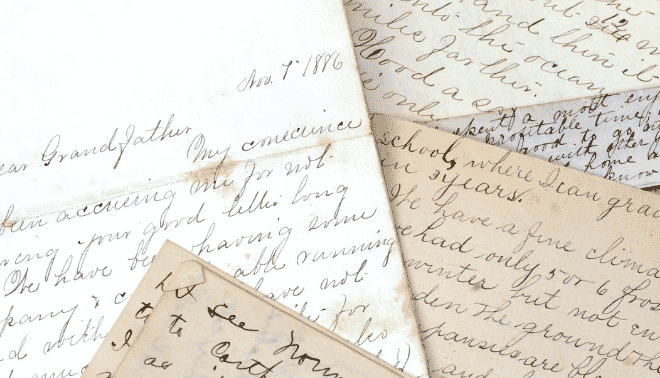
Genealogists treasure handwritten letters because they reflect ancestors’ thoughts and experiences in their own words, on paper they handled. Correspondence provides a rare personal connection with ancestors. Whether you inherit Grandma’s missives or find your Civil War soldier’s last letter home in a public archive, here’s how to preserve these writings as part of your family history.
Q: How can I preserve a bundle of my grandfather’s letters to home when he was serving overseas during World War II? They’re in the original envelopes, wrapped with broken rubber bands.
A: Your collection is doubly valuable as a resource both for your family history and the country’s broader wartime history. As you take measures to preserve the letters, study them for news of friends and family that you can extract and confirm for your family tree. You’ll also want to read the letters for insight into the personality and everyday life of your grandfather and his buddies.
The durability of old documents depends on both the type of paper and the storage conditions. Paper made before around 1865 consists of cotton fibers, whereas most papers after that date are a combination of wood pulp and lignin. Lignin is the substance that makes your newspaper turn yellow in sunlight. In the late 19th century, stationery used for letter writing could be either type of paper.
Once you’ve investigated what type of paper they are written on, here are a few steps you can take to preserve your old letters:
- Work on a clean surface with freshly washed hands, and avoid handling the letters more than necessary.
- Remove
and discard those failing rubber bands, which can leach chemicals that
can harm your letters, but make note of how the letters are grouped.
This may help you identify mysterious references to people and events a
relative mentions having previously written about. If the paper is
brittle and cracking, don’t force pages open. Instead, allow the loosely
folded pages to sit undisturbed for a few hours. Often, the paper will
absorb enough moisture from the air to relax and become easier to
handle.
- Open the letters one at a time and remove any
foreign objects, especially staples, straight pins or paper clips; these
tend to rust and damage paper over time. Keep pages together in their
original order by placing each letter with its envelope in an individual
acid-free, lignin-free archival file folder. This type of storage
material is available from a variety of archival suppliers, such as Hollinger Metal Edge and Archival Methods.
- Digitize the letters by scanning them on a flatbed scanner (scan the envelopes, too, if you have them) at a resolution of 300 dpi (dots per inch).
Avoid sheet-fed scanners, which are fine for modern papers but can
damage fragile heirloom documents. Use the digital versions for
transcribing the letters and making copies to share; preserve the
original letters in your home archive.
- Store the folders upright in a metal filing cabinet or acid-free archival document box located in an area of your home with consistent temperature and relative humidity. A closet on an inside wall is ideal.
More Letter Preservation Tips
A numbering system can help you keep track of which letters were bundled together and in what order: You could label the outside of a file folder Bundle A, Letter 2, George Longworth to Bessie (Meyers) Longworth, 6 March 1942. Then organize folders chronologically by date, author or addressee, depending on your purpose and the size of your collection.
If you didn’t inherit your great-grandfather’s wartime letters, perhaps another descendant did. Family letters also may have ended up in a historical archive or library where researchers can view them. Use these tips to start your search for long-lost letters:
- Identify ancestors who lived away from home due to military service, migration or some other reason. With whom might they have corresponded? Also note ancestors who were prominent community members.
- Query descendants of letter writers and potential recipients about any documents they’ve inherited.
- Google the names (be sure to try women’s maiden names) and hometowns of the above ancestors to find blog posts, website mentions or items for sale on eBay.
- Search catalogs and websites of archives and libraries in ancestral hometowns. Next, search for names of family, friends and neighbors who may have mentioned your family in their correspondence.
- Search the National Union Catalog of Manuscript Collections through the Library of Congress portal. This catalog helps you find personal and family manuscript collections from throughout the United States.
- Try to connect with others tracing your family. Look at images they’ve added to their trees. If your own family tree image gallery is bare, post a “teaser” image from your collection to encourage others to get in touch with you.
No comments:
Post a Comment